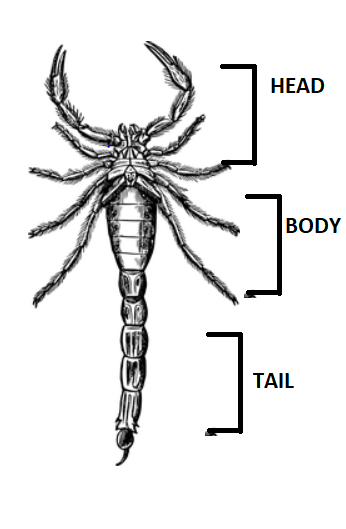
Body of scorpion is divided into which of the following parts?
A Head, thorax and abdomen
B Prosoma and opisthosoma
C Thorax and abdomen
D Head and cephalothorax
Answer
500.1k+ views
Hint An arthropod is a segmented invertebrate animal with paired jointed appendages and an exoskeleton. Insects, arachnids, myriapods, and crustaceans all belong to the phylum Arthropoda, which comprises arthropods.
Complete step by step answer:
Scorpions belong to the order Scorpiones, which are predatory arachnids. They have eight legs and can be distinguished by a pair of gripping pincers and a slender, segmented tail that often curves forward over the back and always ends in a stinger.
Scorpions come in a variety of sizes, starting at 8.5 mm (0.33 in) The cephalothorax, or prosoma, and the abdomen, or opisthosoma, are the two tagmata that make up a scorpion's body. The opisthosoma is divided into two sections: a broad front piece, known as the mesosoma or pre-abdomen, and a narrow tail-like posterior section, known as the metasoma or post-abdomen.
Arthropods, which include scorpions, are a type of arthropod. There are eight legs on them. They have two scissor-like chelates on their pedipalps and a venom-injecting barb on their tail. The prosoma, or cephalothorax, mesosoma, or opisthosoma, or abdomen, and metasoma, or tail, are the three segments of the body.
During courting, the male and female scorpions grab each other's pincers and move around in a "dance" in which the male tries to coax the female onto his sperm packet. All known species give live birth, and the mother takes care of the young while their exoskeletons solidify, carrying them on her back. The exoskeleton is made up of fluorescent compounds that shine when exposed to UV light.
As a result, option B is the proper response.

Note: The majority of scorpion species are nocturnal or crepuscular, hiding in burrows, rock fissures, and tree bark during the day. [60] Many species build a shelter behind a few centimeter-long stones.
Complete step by step answer:
Scorpions belong to the order Scorpiones, which are predatory arachnids. They have eight legs and can be distinguished by a pair of gripping pincers and a slender, segmented tail that often curves forward over the back and always ends in a stinger.
Scorpions come in a variety of sizes, starting at 8.5 mm (0.33 in) The cephalothorax, or prosoma, and the abdomen, or opisthosoma, are the two tagmata that make up a scorpion's body. The opisthosoma is divided into two sections: a broad front piece, known as the mesosoma or pre-abdomen, and a narrow tail-like posterior section, known as the metasoma or post-abdomen.
Arthropods, which include scorpions, are a type of arthropod. There are eight legs on them. They have two scissor-like chelates on their pedipalps and a venom-injecting barb on their tail. The prosoma, or cephalothorax, mesosoma, or opisthosoma, or abdomen, and metasoma, or tail, are the three segments of the body.
During courting, the male and female scorpions grab each other's pincers and move around in a "dance" in which the male tries to coax the female onto his sperm packet. All known species give live birth, and the mother takes care of the young while their exoskeletons solidify, carrying them on her back. The exoskeleton is made up of fluorescent compounds that shine when exposed to UV light.
As a result, option B is the proper response.

Note: The majority of scorpion species are nocturnal or crepuscular, hiding in burrows, rock fissures, and tree bark during the day. [60] Many species build a shelter behind a few centimeter-long stones.
Recently Updated Pages
The number of solutions in x in 02pi for which sqrt class 12 maths CBSE

Write any two methods of preparation of phenol Give class 12 chemistry CBSE

Differentiate between action potential and resting class 12 biology CBSE

Two plane mirrors arranged at right angles to each class 12 physics CBSE

Which of the following molecules is are chiral A I class 12 chemistry CBSE

Name different types of neurons and give one function class 12 biology CBSE

Trending doubts
One Metric ton is equal to kg A 10000 B 1000 C 100 class 11 physics CBSE

What is 1s 2s 2p 3s 3p class 11 chemistry CBSE

Discuss the various forms of bacteria class 11 biology CBSE

State the laws of reflection of light

Explain zero factorial class 11 maths CBSE

An example of chemosynthetic bacteria is A E coli B class 11 biology CBSE




